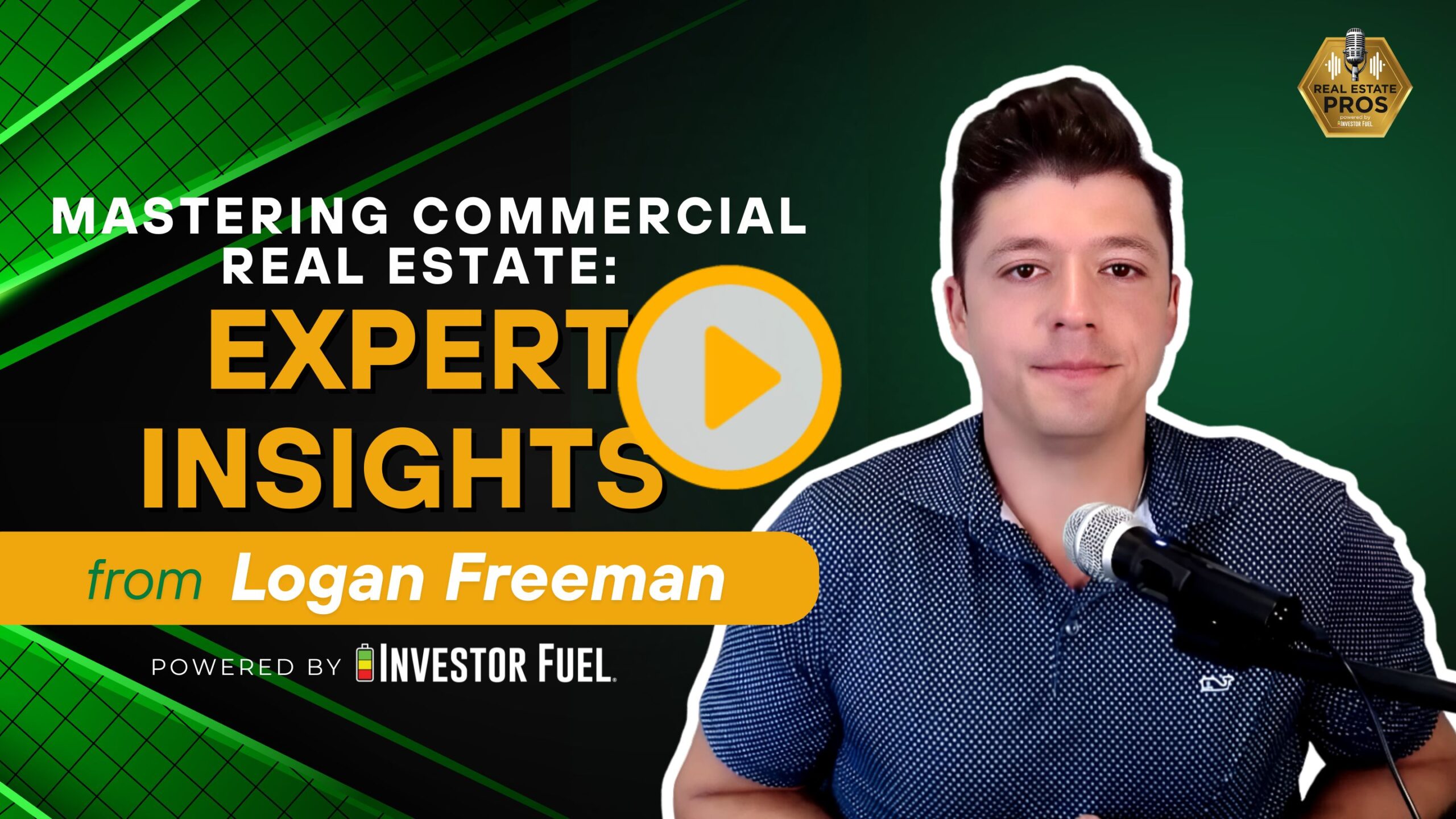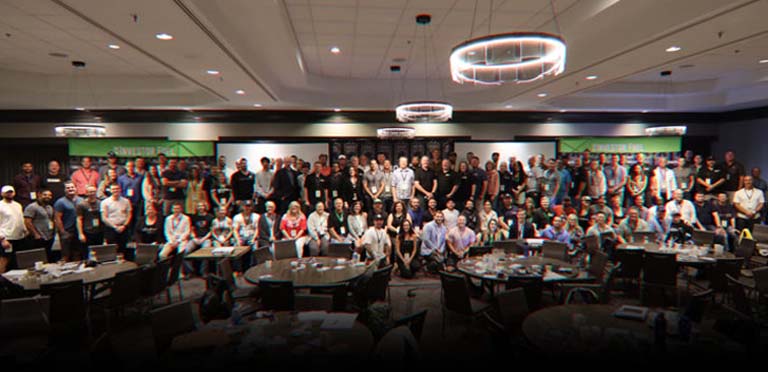
Show Summary
In this conversation, Logan Freeman shares his journey into the real estate industry, detailing his transition from a sales consultant to a successful real estate investor and advisor in Kansas City. He discusses the importance of building relationships with investors, strategies for finding properties, and the metrics involved in commercial real estate. Logan also explores the challenges and opportunities in land development and affordable housing, emphasizing the significance of understanding market trends and municipal planning.
Resources and Links from this show:
Listen to the Audio Version of this Episode
Investor Fuel Show Transcript:
Dylan Silver (00:02.754)
Hey folks, welcome back to the show. I’m your host, Dylan Silver. And today on the show, we have Logan Freeman with Midwest Commercial Real Estate Advisors with one mission, blueprinting Midwest growth out in Kansas City. Logan, welcome to the show.
Logan Freeman (00:22.088)
Thanks, Dylan. It’s my pleasure to be here excited to dive into some of these topics with you.
Dylan Silver (00:26.902)
Absolutely, it’s great to have you on. I always like to start off at the top of the show by asking folks how they got into the real estate space.
Logan Freeman (00:34.27)
Yeah, well, I’ve asked, have my own show and I’ve asked that question to a lot of people. And I think my, my, my journey into this space is similar to many folks is it wasn’t planned, right? It just, it kind of sort of happened. And so, you know, I was fired from my last W2 job at the end of 2017 and I was reading a lot of books, doing some home flips myself here in Kansas city, but I wasn’t necessarily a hundred percent sold on going into real estate.
And so I started a sales consulting company. I just grabbed Inc’s fastest 5,000 growing companies and I called the first 2,500 of them and I landed three full-time clients. Well, I had a buddy that was helping me with these houses and he basically said, Hey man, like I just got a big allocation of capital. I’m representing a $50 million fund here in Kansas city and my head of acquisitions just left. And so I said, well, I’m your guy. And so now I’ve got two full-time gigs, right? I’m
out there as a head of acquisitions for a $50 million fund, and I’m doing this sales consulting. And six months in, after doing about 65 transactions on the real estate side, my wife, who has very strong strategic brain, said, all you do is complain about this consulting, and all you do is talk about real estate. And so I focused and went all in on real estate, and I’ve been doing it ever since.
Dylan Silver (01:59.33)
What year did you go all in on?
Logan Freeman (02:01.438)
2018.
Dylan Silver (02:03.438)
2018. So you saw quite a bit of change. mean, just that doesn’t feel like that long ago, but there’s two totally different real estate markets, right? So you were getting into it at a time, probably when things were maybe nearing or at all time highs, when there was lots of activity and lots of investment, but you’d also done, it sounds like flips beforehand. What had been your experience up to that point in time?
Logan Freeman (02:07.73)
Yes.
Logan Freeman (02:27.688)
You know nothing really. mean I just read a bunch of books about real estate. I was doing a W2 job in the sales world but I hadn’t really done any real estate outside of just my own single family home flips. And then you know this gentleman who had this fund really took me under and I you know we were buying houses to do the buy renovate rent out refinance model. And you know we did two hundred and sixty five of those in about 18 months. You know so I learned quick.
I learned fast, I was estimating rehabs, I was helping with the leasing, I was helping finding the deals. So I got thrown right into the fire. And I took that same kind of methodology and started doing the same type of work on commercial and multifamily assets. And that’s what I’ve been doing ever since. So really, I got to be able to be kind of a guinea pig and learn with somebody else’s capital that I was just a vendor on and able to.
to get a lot of transactions under my belt before I went and purchased my first property.
Dylan Silver (03:29.41)
Now, at which point in time did you decide, hey, I’m gonna start doing this on my own? Was that always your game plan to start doing it on your own?
Logan Freeman (03:38.046)
No, it wasn’t. You know, I think that the fund basically stopped and I was able they stopped purchasing because of the pricing started to get a little high in 2019, 2020. And so they kind of shifted their gears, which got me thinking maybe I should step back and, you know, you know, evaluate what I’m doing. and I saw some really difficult scenarios that they were dealing with, you know, I mean, scattered site management across 265 homes.
is not easy to do. You’ve got a broad geographic location. so I said, well, maybe I should evaluate looking at having, you know, 100, 150 of these in one location and what that looks like. And so I had to go learn underwriting for multifamily and commercial real estate. And that’s, that’s how I did it as well. I started to find 1031 exchange buyers that didn’t live in Kansas city. And I’d say, Hey, if you’re doing a 1031 and you’re in California, you’re in
You know, Florida, Texas, wherever, you know, our units are about 50 to $75,000 here. You can buy 10 of them for 750,000. Yeah. And that really piqued a lot of people’s interest. And this is kind of pre, you know, Kansas city really being on the map, I would say, and we had good deals here, you know, I mean, we really did. And so I went and learned again on another 50 to a hundred transactions on the commercial real estate, retail shopping centers and multifamily assets, which allowed me to.
Dylan Silver (04:43.918)
It’s rain.
Dylan Silver (04:56.098)
That’s exactly right.
Logan Freeman (05:05.479)
to get the experience I needed.
Dylan Silver (05:07.512)
You know, those homes in like SoCal, Southern California, I wanna say, I spoke with two people recently, so I have two data points, although I’m not a realtor out there, but supposedly it’s like $1.2 million for the average home in that area. And you talk about the price point where it is in Kansas City. So people are able to do, you know, this dollar arbitrage or this geographic arbitrage from taking their single family home or maybe a rental property.
that they bought for, you know, two, 300 grand 20 years ago. Now it’s 1.2, 1.4, 1.6. And then how many deals can they, you know, take down in Kansas City? And they didn’t necessarily have that connection, you know, they didn’t have a Logan Freeman in their area. So when you were reaching out to these people, were these like completely cold interactions? Or were they familiar with the deals that you had or with who you were? Or was this
really establishing relationships and then trying to present them deals that you had.
Logan Freeman (06:05.672)
Well, yeah, two things on that, which you’re kind of describing is, geographic arbitrage, but also return on equity. You know, I mean, you’re sitting on 500, $700,000 of equity, but your net operating income and your property has not increased, you know, from a pro rata standpoint. And so you’re able to trade that in and get a much better return on equity utilizing a 1031 exchange. This is when bigger pockets forums was where all the rage was, Dylan. And so I used to have tags set up.
on bigger pockets forums and anybody that mentioned Kansas City, I would get an email and so I would just say, hey, you know, I’m in the forums on a regular basis, just adding value about the different sub markets in Kansas City, what deals are trading at. Hey, I’m here active looking for deals for people and just, mean, I remember having a countdown link and sending them direct messages and my weeks looked like I was either in the field looking at properties or I was on the phone doing 30 minute calls.
with investors that were out of state. And that’s how I built that business up. And people started to catch on. And I think BiggerPockets caught on as well, saying a lot of deals are being done here, and we don’t like that. And so they kind of shut that down. so I transferred over to LinkedIn. And for seven or eight years now, I’ve been posting daily on LinkedIn. So about 90 % of my new business is generated.
off of the brand that I have created on LinkedIn. And I’m a top voice there with about 35,000 followers now and just have everything on that platform. So it’s always been be out there building the brand, building the messaging, whether that be BiggerPockets or LinkedIn or YouTube or a podcast, I was an early adopter, I think, on all of those platforms and that helped out a lot.
Dylan Silver (07:51.724)
I want to get granular and talk about strategy for meeting investors and then also for finding these properties. It sounds like from the marketing standpoint, you really are excellent, really ripping the cover off the ball at connecting with investors, reaching out to them. You mentioned bigger pockets. I I’ve heard all different types of ways to get in touch with investors. Never did I think forum on bigger pockets, but
That’s some really creative thinking. On the flip side, getting these properties under contract, what did that look like? Were you finding these properties on market somewhere? Were these off market? Are they distressed or are they rent ready?
Logan Freeman (08:33.662)
Yeah, I took the same approach that I did with the single family homes. You know, I mean, I would find a good sub market and I’d start walking, you know, and there might’ve been one listed property. So I had a target that I was going to go evaluate the listed property. And then I’m walking that sub market. What other deals are on this street that may be able to be purchased, but they might not be marketed. Right. And so I built an online platform called the exchange, uh, which was this off market database that had properties.
that were not listed. And I remember during COVID when people weren’t listing their properties, or maybe it was right before COVID, I had more deals on my off market database platform than LoopNet and Crexie did in Kansas City. And so we became kind of the go-to place, right? And so it was a mix. I mean, in 2018 and 19, there were still good deals marketed. I’m telling you, I I did $40 to $50 million of real estate off of marketed, listed.
Dylan Silver (09:27.031)
Yeah.
Logan Freeman (09:31.486)
projects in Kansas City and then that shifted and so then we had to start finding off-market properties So we would just be doing outreach to property owners lots of cold calls lots of email campaigns Lots of direct mail pieces and then lots of door knocking to try to figure out who owned these properties And so I mean there is no silver bullet. It was no, know that people say that all the time It was just that is the strategy we’re gonna do it on a daily basis and we execute it right and so
that created an opportunity for us to say, we have the buyers now, now we have the properties, they don’t want to list, but they say, bring me an offer. And we’re able to create kind of an online marketplace that wasn’t anywhere else at the time.
Dylan Silver (10:14.272)
And so I want to dive into the commercial real estate space out there in Kansas City. think a lot of I’m an agent in Dallas. I think a lot of people want to get into the commercial space. I love single family and I love now land, which I’ll ask you about here in a bit,
a commercial space, I know it’s not necessarily an easy egg to crack or to get into. Was your ability to get into the commercial space due to that mentor that you had or was this more of a conscious effort that I’m going to move my business into commercial?
Logan Freeman (10:44.68)
Yeah, I I brought my idea to that mentor and he said, I don’t know anything about commercial real estate and you’re gonna get eaten by the big dogs, the big fish. And I said, okay, well, here’s my two weeks. And so I went and left. And so I just grabbed every book that I possibly could. And I think it was Frank Gallanalli’s book. Maybe that’s the last name is incorrect, but it said something around all of the deal metrics you need to know how to understand, right? And so.
That was cash on cash, equity multiple, internal rate of return, all of these different things was I needed to learn how to underwrite these deals. And so one of the things that I did was every listed deal that was out there, I would go get the rent roll, the T12s, and I would start underwriting these projects. And I was building an email list for quite some time. And so I started to send my fully underwritten deals out to the email list. And a lot of these multifamily purchasers, they were like, Hey, I have never really looked at industrial.
or I’ve never really looked at retail shopping centers. I’m in California and retail’s dying out here. How is it doing in Kansas City? Well, it’s thriving out here and now everyone wants to buy retail shopping centers, right? It’s like the darling of the commercial real estate industry. Well, so it was really just kind of getting into the books, then going and getting some active deals and then underwriting those deals and figuring that stuff out, you know, deal by deal. And I probably did that thousands of times. And so I have reps.
now that I can look at a property and be able to underwrite that thing. Well, I have tools now as well, Dylan, that allow me to underwrite deals much easier than I was seven or eight years ago. Shout out to Intel CRE. That’s my underwriting software. I freaking love it. I can get through a deal so fast. So anyways, it was all about understanding those metrics, understanding those sub-markets. Where’s the occupancy? Where’s the vacancy? What’s coming online from a new construction standpoint?
Dylan Silver (12:22.584)
Yeah.
Logan Freeman (12:40.54)
and then putting a thesis together to say, think that this asset class is going to be very strong. Here’s why, and here’s four or five opportunities in that asset class. And that strategy seemed to be successful.
Dylan Silver (12:52.15)
Now, I want to ask you about getting these deals under contract and maybe give away some gold, but not all the gold here, Logan. talking about commercial deals, mean, commercials at different scale, have a different level of risk compared to single family, of course. But when I think about the single family space and if I think about arbitraging an off market deal or even an on market deal to another investor and I have to get it under contract myself,
I’m putting up option money, I’m putting up EMD, or maybe I might be doing a double close with a commercial deal and you have investors. If the property is already listed, what are you doing to make sure that your interests are protected and they’re not gonna go around you?
Logan Freeman (13:33.512)
Yeah, I mean, I didn’t make sure, Dylan, and that’s the thing. Everybody, and I’m not saying to do that. However, I think through the time and the education component that I took with them being on my email list, they came off of LinkedIn or BiggerPocketsForum, I was their entry point into Kansas City. I never signed exclusive buyer agency agreements. They were always non-exclusive. I let them go and evaluate or work with other people. I just said,
I think my work ethic and my process, what I call the buyer representation success system or the BRSS is going to provide enough value that you won’t go anywhere else. And that proved to be successful. I’m sure I lost some deals, right, with people going around me, but I had enough in the pipeline and enough of those buyers that trusted me to say, okay, I’m going to bring your contractor, your property manager, your lender, your insurance person, your accountant, whatever you need. It was almost like,
a white glove service, but I was just a real estate broker. And so I kind of productized this offering that said it’s a one stop shop. I’ve got everything you need. You don’t have to go anywhere else. And I just had goodwill and trust built with those buyers and those investors that allowed me to build a business that
Dylan Silver (14:47.81)
I want to pivot Logan and talk about land and talk about new developments. I’m really big on infill lots because that’s kind of the play that I’m looking at at the level that I’m at personally. And I just think, know, so much, I would say opportunity for affordable housing, although it sounds like you’re doing a new build, how affordable could it be? But when you compare it to fix and flips and when you compare it to the other options that people have, I think we’re going to see a lot more.
manufactured a lot more ADUs, alternative dwelling units. Curious to get your feedback on land and affordable housing.
Logan Freeman (15:23.176)
Yeah, well, I I think that land has always been interesting because it’s a scarce resource, right? And Ricardo’s law of economic rent basically states that the value of land is not derived from the capital or the effort that you put into it. It’s derived from its scarcity and production capacity. And so path of progress is so important. So understanding where the new infrastructure is going, understanding where new schools are going.
understanding where new highways are going. That is where you want to be. And so what I have done is I’ve tried to go and learn about the municipalities that I’m interested in investing in and or helping people invest in. And they put out frameworks, they put out comprehensive vision plannings. And in those, in those documents, they have maps and in those maps, they have locations. And so I would start to find those locations, then drive those locations, walk the streets, see where the opportunity was.
and say, my gosh, you know, like there’s the city is telling me this is where they want to incentivize growth. And this is, you know, a part of their comprehensive plan. How do I merge what I’m trying to do, which one of the strategies is attainable housing with that. And so it’s become kind of a public private partnership scenario where we are finding creative solutions to three to five acre infill lots to be able to say, hey, if we change the zoning, which used to be single family home here,
Dylan Silver (16:49.474)
Right.
Logan Freeman (16:49.49)
you change the zoning and allow me to put 10 to 12 units per acre on this property, as well as help subsidize some of the infrastructure costs, I can bring you for sale new entry level homes in a great area for 400 to $500,000. And that has been well received in many of these municipalities. And that takes a lot of effort, it takes a lot of work, and it takes a lot of time.
But if you can figure that out, is what’s called, I believe, one of these blue ocean strategies that has a high barrier of entry. It takes a specialized skill set and relationships to be able to complete. And that’s the type of arena that I’m trying to play in.
Dylan Silver (17:32.43)
You know to your point I think there’s a lot that goes in there you mentioned I mean relationships with the city officials But you mentioned rezoning and then you also have to be knowledgeable in Development as well unless there’s someone else is going to come in and do this So it’s really three different hats a lot of investors I’ve spoken with them are necessarily thrilled about having to deal with zoning issues and you know Working with city officials and so on and so forth But then also new builds is a totally different game than really anything
else. So being able to wear those multiple hats is really where I think you you have an amazing niche and even if you could only do maybe one of those it would be a great niche but combine all three is really impressive. Logan we are coming up on time here. Where can folks go to learn more about your business or to get in contact with you?
Logan Freeman (18:22.418)
Yeah, please do find me on Kansas City or on LinkedIn. Mr. Kansas City, Logan Freeman, LinkedIn. I post everything there on a regular basis, deal breakdowns, newsletters, all the new projects that we’ve got. You can find me on, on LinkedIn. I’m there every single day. So please do connect with me there.
Dylan Silver (18:41.506)
Logan, thank you so much for coming on the show here today.
Logan Freeman (18:44.626)
Thanks for having me, Dylan.






